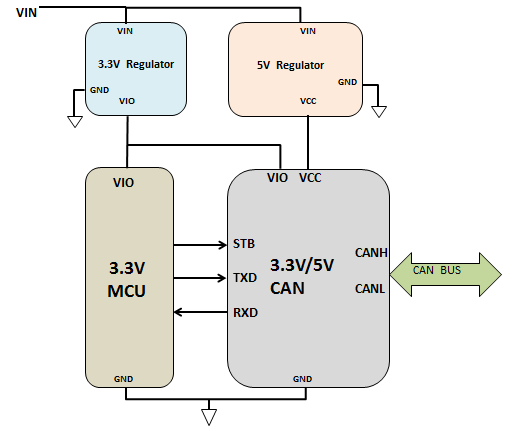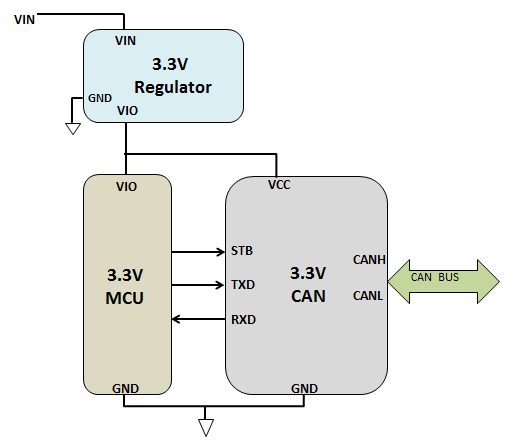SSZTAR6 october 2016 SN65HVD234 , TCAN334
Controller Area Network (CAN) systems have traditionally been based around 5-V supplies. However, 3.3-V CAN controllers and transceivers are becoming increasingly popular as well. In this post, I’ll list the top five reasons to use a 3.3V-based setup in your factory automation design and address a couple of questions that typically arise.
1. Simpler system design.
Figure 1 shows a typical CAN system involving a CAN microcontroller (MCU), a transceiver and two power supplies. A 5-V supply drives the CAN bus, whereas a 3.3-V supply is used for the CAN controller and I/O pins such as TXD and RXD. While this approach helps minimize power consumption on the controller and for the I/O logic, as you will see shortly, there is room for further improvement.
 Figure 1 Typical CAN Setup with 5V and 3.3V Supplies
Figure 1 Typical CAN Setup with 5V and 3.3V Supplies3.3-V CAN transceivers simplify system design by eliminating the need for a separate 5-V rail. As Figure 2 shows, the setup can run on 3.3V alone. Using only a 3.3-V supply eliminates any potential concerns about two rails ramping up at different rates, any sequencing challenges or having to worry about different signal levels. There is just one rail to keep track of, and all signals are on this one rail.
 Figure 2 Typical CAN Setup with a Single 3.3-v Rail
Figure 2 Typical CAN Setup with a Single 3.3-v Rail2. Reduced cost and board space.
A simpler system directly translates to multiple benefits. Since you no longer need the 5-V rail, you save the cost of an extra regulator and its associated capacitors. It is also an easy way to save crucial board space. Further, if you use a part from the TCAN33X family, such as the TCAN334, you can use the more compact SOT23 2.8mm X 2.9mm package, instead of the conventional 8-pin SOIC 6mm X 4.9mm package. This alone represents a significant area reduction: more than 70%.
3. Reduced power.
Power consumption also comes down across the board with a single, lower-voltage 3.3-V rail, as shown in Figure 3. In addition to the power savings gained by eliminating the extra regulator, there are significant savings in the transceiver itself, both in the form of lower current and lower voltage.
 Figure 3 Supply Current Comparison
between 3.3V and 5V Transceivers
Figure 3 Supply Current Comparison
between 3.3V and 5V TransceiversAs you can see, the power savings are nontrivial, with the 3.3-V parts pulling significantly less current in both Dominant and Recessive states, and across load conditions. The lower power dissipation numbers also translate to more relaxed thermal constraints on the system.
4. Compatible with CAN standard requirements.
A question that immediately comes up with 3.3-V parts is whether the driver section of the transceiver is strong enough to drive the appropriate signal levels on the CAN pins. The short answer is yes! The driver is indeed capable of doing so. The CAN standard requires that the Vod value (the voltage difference between CANH and CANL) in Dominant state be between 1.5V and 3V on a standard load. Intuitively, this is relatively easier to meet with a 5-V supply rail, which offers more headroom. However, by using better process technologies with more efficient transistors (lower RDS(on)), and with appropriate sizing and other good design techniques, the internal voltage drops in the driver are minimal, and you can still meet the Vod specification reliably over process, voltage and temperature corners.
Further, the CAN standard allows for additional voltage margin for transmission losses between a driver and a receiver. For example, in the worst-case scenario, even if a driver transmits a Dominant bit with a 1.5-V swing (the minimum allowed value), the receiver only needs 0.9V (the maximum threshold value) to be successfully acknowledged as a Dominant bit. Thus, in normal mode, the worst-case delta is 0.6V, which still offers good noise margin. In low-power standby mode, where line losses are lower (smaller currents), the receiver maximum threshold is 1.15V, so a driver capable of driving a 1.5-V signal on the bus would still be able to send a Dominant bit successfully, with a 0.35-V worst-case margin.
Although I have discussed only Vod, the same holds true for other parameters as well: 3.3-V transceivers still have to meet all relevant CAN standard parameters to be classified as a valid CAN device.
5. Compatible with existing 5-V transceivers.
Another important thing to evaluate is compatibility with existing 5-V networks. Figure 4 shows the typical common-mode bias set point for different transceiver families. There is a <1V common-mode shift between 3.3-V transceivers and their 5-V counterparts. However, as Figure 4 shows, this small shift is well within the common-mode range specified by the CAN standard and therefore does not affect functionality or interoperability.
 Figure 4 Comparison of Common-mode
Values in Different Transceivers
Figure 4 Comparison of Common-mode
Values in Different TransceiversCommunications and Systems (C&S) Group GmbH, a widely recognized third-party organization that certifies transceivers from different companies worldwide for CAN compliance, carried out detailed conformance testing of the SN65HVD234 family. Exhaustive testing of a network of 3.3-V transceivers mixed in with 5-V devices revealed no issues with compatibility or interoperability, and the devices were rated by C& S to be fully compliant.
3.3-V transceivers offer a wide range of benefits: simpler setup, reduced cost, lower power and smaller area compared to their 5-V counterparts. They are fully compliant with CAN standards and also compatible with existing 5-V networks.
To learn more about how to implement 3.3-V CAN transceivers, download the application note, “Overview of 3.3V CAN (Controller Area Network) Transceivers.”
Additional Resources
- Check out 3.3V transceiver portfolio and our entire CAN transceiver portfolio.
- Learn more about common-mode voltage for industrial transceivers.
- For questions, contact us on the TI E2E™ Community Interface forum.